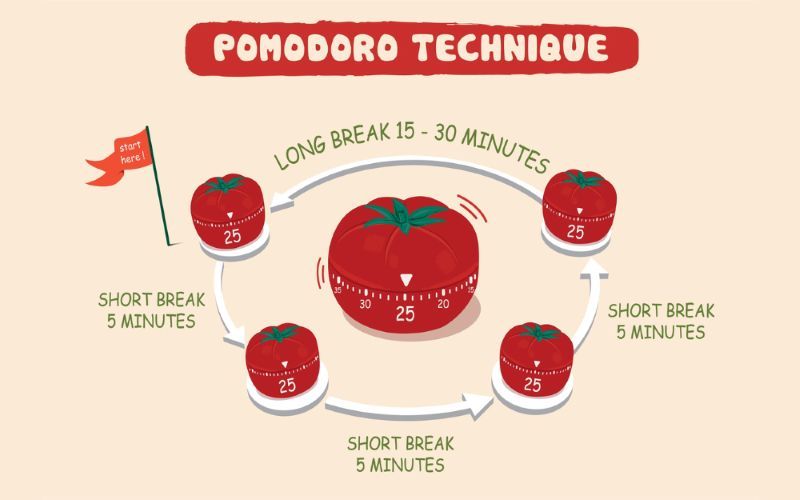

Are you tired of procrastination holding you back? Discover how the Pomodoro Technique can revolutionize your productivity and help you achieve your goals. Let's learn more about this topic below with Iron Snout.
The Pomodoro Technique is a time management method developed by Francesco Cirillo in the late 1980s. It's named after the tomato-shaped kitchen timer Cirillo used as a university student. The technique involves breaking work into focused intervals, typically 25 minutes long, separated by short breaks.
This method is designed to improve focus and productivity by leveraging our natural attention spans. By working in short bursts, we can maintain high levels of concentration and avoid burnout. The Pomodoro Technique is particularly effective for tasks that require sustained mental effort.
The basic structure of the Pomodoro Technique is simple. You work for 25 minutes, then take a 5-minute break. After four "pomodoros," you take a longer break of 15-30 minutes. This cycle repeats throughout your workday, helping you maintain focus and energy.
To begin using the Pomodoro Technique, you'll need a few simple tools. First, choose a timer. This can be a physical kitchen timer, a smartphone app, or a website designed for pomodoros. Many people find that a dedicated timer helps them stay focused and avoid distractions.
Next, create a to-do list for your day. Break larger tasks into smaller, manageable chunks that can be completed in 25-minute intervals. This step is crucial for making the most of your pomodoros and avoiding overwhelm.
Set up your workspace to minimize distractions. Close unnecessary browser tabs, silence your phone, and let others know you'll be unavailable during your work intervals. Creating a conducive environment is key to successful pomodoros.
Choose a task from your to-do list and set your timer for 25 minutes. During this time, focus solely on the chosen task. If you finish before the timer goes off, use the remaining time to review or improve your work.
When the timer rings, stop working immediately. This is important for training your brain to focus intensely during work periods and relax during breaks. Take a 5-minute break to stretch, grab a drink, or do something enjoyable.
After your break, start your next pomodoro. If you complete four pomodoros, take a longer break of 15-30 minutes. This extended break helps prevent mental fatigue and keeps you refreshed for the next set of pomodoros.
One of the biggest challenges when using the Pomodoro Technique is dealing with interruptions. If someone interrupts you during a pomodoro, politely inform them that you're in the middle of a focused work session and will get back to them shortly.
If you remember an unrelated task during a pomodoro, quickly write it down and return to your current task. This helps prevent your mind from wandering and keeps you focused on the task at hand.
Sometimes, you may feel the urge to check your phone or browse the internet during a pomodoro. Resist this temptation. Remember that these distractions can wait until your next break. Stay committed to the task you've chosen for the current pomodoro.
While the standard Pomodoro Technique uses 25-minute work intervals, you can adjust this to suit your needs. Some people find that 30 or 45-minute pomodoros work better for them. Experiment with different durations to find what works best for you.
If you're working on a task that requires deep focus, you might find that longer pomodoros are more effective. Conversely, if you're struggling with motivation, shorter pomodoros can help you build momentum and overcome procrastination.
Remember that the Pomodoro Technique is a tool, not a strict set of rules. Feel free to adapt it to your work style and the specific demands of your tasks. The key is to find a rhythm that enhances your productivity and focus.
To get the most out of the Pomodoro Technique, it's important to track your progress. Keep a record of the number of pomodoros you complete each day and the tasks you accomplish. This can help you identify patterns in your productivity and make improvements over time.
Use your breaks wisely. While it's tempting to check social media or emails during breaks, these activities can be mentally draining. Instead, try doing something physical like stretching or taking a short walk. This helps refresh your mind and body for the next pomodoro.
The Pomodoro Technique can also help you estimate how long tasks will take. As you use the technique more, you'll develop a better sense of how many pomodoros different types of tasks require. This can improve your planning and time management skills.
The Pomodoro Technique can be combined with other productivity methods for even greater effectiveness. For example, you can use the "Eat the Frog" technique to tackle your most challenging task in your first pomodoro of the day.
You can also incorporate the "Two-Minute Rule" into your pomodoros. If you notice a task that will take less than two minutes to complete, do it immediately rather than adding it to your to-do list. This helps prevent small tasks from piling up and becoming overwhelming.
Consider using a task management system like Kanban or GTD (Getting Things Done) alongside the Pomodoro Technique. These systems can help you organize your tasks and prioritize your pomodoros more effectively.
The effectiveness of the Pomodoro Technique is rooted in cognitive science. Our brains are not designed for extended periods of focused attention. Research shows that our ability to concentrate declines after about 90 minutes of sustained effort.
By working in shorter bursts, we can maintain higher levels of focus and productivity. The regular breaks in the Pomodoro Technique allow our brains to rest and recharge, preventing mental fatigue and burnout.
The technique also leverages the psychological principle of timeboxing. By setting a specific time limit for a task, we create a sense of urgency that can help overcome procrastination and increase motivation.
Studies have shown that taking regular breaks can improve cognitive function and creativity. During breaks, our brains enter a "diffuse mode" of thinking, which can lead to new insights and solutions to problems we've been working on.
The Pomodoro Technique also helps reduce decision fatigue. By deciding in advance what task you'll work on during each pomodoro, you free up mental energy that would otherwise be spent on moment-to-moment decisions about what to do next.
Regular breaks can also help reduce stress and improve overall well-being. The structured nature of the Pomodoro Technique can provide a sense of control and accomplishment, which can boost mood and motivation.
One common challenge when using the Pomodoro Technique is the temptation to continue working when you're in a state of flow. While it may seem counterintuitive, it's important to take breaks even when you're feeling productive.
If you find yourself consistently unable to focus for 25 minutes, start with shorter pomodoros. You can begin with 15-minute work intervals and gradually increase the duration as your concentration improves.
Some people struggle with the rigidity of the Pomodoro Technique. If this is the case for you, remember that flexibility is key. It's okay to adjust the technique to fit your needs, as long as you maintain the core principle of focused work followed by breaks.
Perfectionism can be a major obstacle to productivity. The Pomodoro Technique can help by encouraging you to focus on progress rather than perfection. Use each pomodoro as an opportunity to move forward, even if the result isn't perfect.
If you find yourself getting stuck on details, set a specific pomodoro for revisions and improvements. This can help prevent endless tweaking and ensure that you make steady progress on your tasks.
Remember that the goal of the Pomodoro Technique is to improve your productivity and focus, not to achieve perfection in every task. Embrace the process and celebrate the progress you make with each pomodoro.
Consistent use of the Pomodoro Technique can lead to significant improvements in your overall productivity and work habits. Many people report increased focus, better time management skills, and reduced procrastination after adopting the